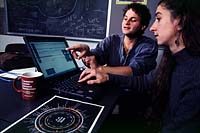

|
STRATEGIC HIRING In cutting-edge research, a sum is much greater than its parts The notion of grouping people with different areas of expertise to solve complex problems is nothing short of revolutionary in higher education. Through the Madison Initiative, UW-Madison developed the model for such strategic hiring – a breakthrough approach that is already producing results. BY BLENDING FACULTY TALENT from biology, chemistry, medicine and computing, a genetics research group at UW-Madison is striving to attain national leadership with a form of academic alchemy. The Genome Center of Wisconsin, an original site for UW-Madison's strategic hiring initiative, hired three new faculty since 1999 with complementary but diverse backgrounds. Organizers say that interdisciplinary focus ultimately will separate the players from the bystanders in this exploding field. "No single person is on the cutting edge of all of the different cutting edges in genomics," says Nicole Perna, professor of animal health and biomedical sciences. Perna is a summer 2000 addition to the faculty who brings expertise in comparative genomics to the group. That talent will be crucial to determining the core differences and similarities across organisms. "Collaboration seems to be the nature of genome science," she adds. "It is simply too enormous a task for any one scientist or any one field. It's amenable to this collaborative approach, which is the whole spirit of strategic hiring." In genomics, many of the intellectual pieces are in place. The first faculty member hired was David C. Schwartz, professor of genetics and chemistry, who is a leader in the development of frontier technologies. Several years ago, he invented pulse-field electrophoresis, a faster genome-mapping method that is now the gold standard of genomics research worldwide. His most recent invention, shotgun optical mapping, is likely to revolutionize the field again. The third hire in the group was Thomas Anantharaman, professor of computer science and medical informatics. Anantharaman, an expert in artificial intelligence, creates software to automate genetics work. His goal is creating software that maps not only single genomes, but groups of individuals at one time. Genome maps help determine whether the thousands of bits and pieces of sequenced genetic material are properly assembled – akin to providing the picture on the cover of a puzzle box. Fred Blattner, director of the Genome Center of Wisconsin who led the hiring effort, says it helped "create something that is far more powerful than the individual parts." The goal was a "bridging project" that would cross the various disciplinary divides in higher education, and get physical scientists and biologists working together. "What we're trying to do is pick a team of the utmost power in terms of the individual investigators," Blattner says. Such teamwork has already produced unexpected sparks. Last year, Blattner, along with biotechnology center director Mike Sussman and electrical engineer Franco Cerrina, came up with a new way of creating DNA chips that allows scientists to analyze thousands of genes at one time. This cost-effective, more-flexible technology has led to the formation of a new company called NimbleGen. It will compete in a gene-chip market that, according to some estimates, will reach $40 billion in the next decade. Technology is another important dimension of the genome center, since it has assembled an impressive array of research hardware. The center recently received a donation of a $2.6 million supercomputer from Sun Microsystems Inc., making UW-Madison one of the company's nine "centers of excellence" in the world. Blattner hopes the center will evolve into a demonstration site for academic uses of the NimbleGen technology. What can all this hardware and talent accomplish? One recent project shows how the new resources work in tandem. The center just completed the genetic sequencing of E. coli O157:H7, a food-borne organism that causes life-threatening illness in an estimated 75,000 people a year. Because the researchers had already completed the sequence of a benign form of this bacteria, they could compare the two for clues about why the strain is so deadly. What they discovered were "islands of pathogenicity," an array of genes that could be hot zones connected to disease. The paper that resulted from this research has more than two dozen co-authors, including all of the aforementioned faculty. "That's how you get a big project done," says Perna.
|

Professor Nicole Perna, working here with postdoctoral student Jeremy Glasner in her university lab, is a member of one of UW-Madison's newest collaborations: faculty members who – though of disparate backgrounds – together are tackling the challenge of genome science.
Related links: Cluster Hiring Initiative (Office of the Provost) |
|
Table of contents | Chancellor's special reports | UW Home | Feedback |
|
|